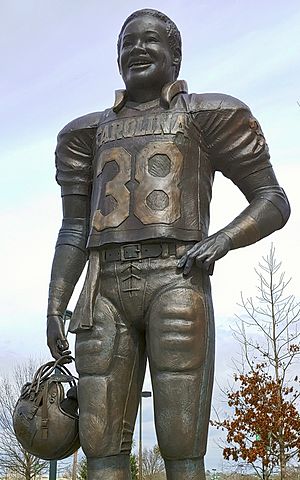George Rogers (American football) facts for kids

Statue of Rogers outside Williams–Brice Stadium
|
|||||||||||
| No. 38 | |||||||||||
|---|---|---|---|---|---|---|---|---|---|---|---|
| Position: | Running back | ||||||||||
| Personal information | |||||||||||
| Born: | December 8, 1958 Duluth, Georgia, U.S. |
||||||||||
| Height: | 6 ft 2 in (1.88 m) | ||||||||||
| Weight: | 228 lb (103 kg) | ||||||||||
| Career information | |||||||||||
| High school: | Duluth | ||||||||||
| College: | South Carolina (1977–1980) | ||||||||||
| NFL Draft: | 1981 / Round: 1 / Pick: 1 | ||||||||||
| Career history | |||||||||||
|
|||||||||||
| Career highlights and awards | |||||||||||
|
|||||||||||
| Career NFL statistics | |||||||||||
|
|||||||||||
| Player stats at PFR | |||||||||||
|
College Football Hall of Fame
|
|||||||||||
George Washington Rogers Jr. (born December 8, 1958) is a former American football player. He was a running back in the National Football League (NFL) for seven seasons. George played college football for the South Carolina Gamecocks. He was recognized as an unanimous All-American and won the famous Heisman Trophy in 1980. He was the very first player chosen in the 1981 NFL draft. George played for the New Orleans Saints and the Washington Redskins.
Contents
College Football Journey
George Rogers was a highly sought-after player in high school. He chose to attend the University of South Carolina because his coach, Jim Carlen, promised he could play in his first year. Even though he was big, people thought he would play as a fullback. But because two other running backs graduated, George started as the main running back during his freshman year.
Becoming a Star Player
In his second year, George rushed for 1,006 yards. This was impressive, even though he shared playing time with another player. In his third year, he gained 1,681 rushing yards. After this great season, he was named a first-team All-American. He also finished seventh in the voting for the Heisman Trophy.
The year 1980 was a big one for the Gamecocks. They had many talented players, and George Rogers was a top candidate for the Heisman Trophy. South Carolina finished the season with a strong 8–3 record. George's 1,781 rushing yards were the most in the entire nation. This made him a finalist for the Heisman Trophy.
Winning the Heisman Trophy
The Downtown Athletic Club in New York City announced George Rogers as the winner of the 1980 Heisman Trophy. He won against other amazing players like Hugh Green and Herschel Walker. George was also named to eight different All-America teams, all as a first-team player.
During halftime of South Carolina's last home game in 1980, George's jersey number 38 was officially retired. He was the first player from the University of South Carolina to have his jersey retired while still playing for the school.
George Rogers left the Gamecocks as their most successful running back. Many of his records are still standing today. His 5,204 career rushing yards are the most by any Gamecock running back. He is also tied for second with 31 rushing touchdowns. George rushed for over 100 yards in 27 games, including his last 22 college games.
Professional Football Career
Joining the NFL
In the 1981 NFL draft, the New Orleans Saints picked George Rogers as the very first player overall. He was the first of five Heisman Trophy winners chosen by the Saints over the years.
In his first season with the Saints, George led the entire league in rushing. He gained 1,674 yards, which was a new record for rookies at the time. This is still the Saints' record for most rushing yards in a single season. He was chosen for the Pro Bowl and was named the NFL Rookie of the Year.
George played his first four seasons in New Orleans. He played alongside quarterback Archie Manning and later with running back Earl Campbell.
Moving to Washington
On April 26, 1985, George Rogers was traded to the Washington Redskins. He played three more seasons for the Redskins. When he joined Washington, famous running back John Riggins was finishing his career. Coach Joe Gibbs was working to rebuild the team.
George had some of his biggest professional successes in Washington. This included winning a Super Bowl title in 1987. The Redskins defeated the Denver Broncos 42–10 in Super Bowl XXII. George retired after the 1987 season due to injuries, ending his career with a Super Bowl victory. When he left the NFL, George Rogers had rushed for 7,176 yards and scored 54 touchdowns in seven seasons.
Honors and Recognition
George Rogers has received many honors for his amazing football career. In 1992, he was named to the All-Century Team at the University of South Carolina. He is a member of several Halls of Fame, including:
- The University of South Carolina Athletic Hall of Fame
- The South Carolina Athletic Hall of Fame
- The South Carolina Football Hall of Fame
- The Georgia Sports Hall of Fame
- The College Football Hall of Fame
- The New Orleans Saints Hall of Fame
The road that runs along the north end of Williams-Brice Stadium was renamed George Rogers Boulevard in his honor. A statue of George was put up on this boulevard in 2015. On December 14, 2017, another road was named after him in his hometown of Duluth, Georgia. It is called George Rogers Avenue.

